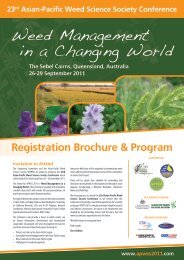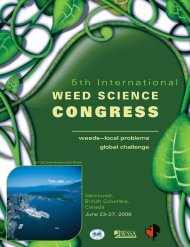PARAQUAT
PARAQUAT
PARAQUAT
Create successful ePaper yourself
Turn your PDF publications into a flip-book with our unique Google optimized e-Paper software.
man had repeated direct contact with paraquat<br />
on his back. He sprayed paraquat and demeton-<br />
S-methyl using a leaking backpack sprayer<br />
and recalled that his clothes would be soaked<br />
in chemicals after a spray session (Anderson &<br />
Scerri 2003).<br />
Laboratory studies have shown that paraquat<br />
causes oxidative stress and damage in mouse<br />
skin cells (Black et al 2008), and oxidative stress<br />
is known to contribute to the development of<br />
cancer (Valko et al 2006), so this may in part<br />
explain the proposed associations between<br />
paraquat and skin cancer.<br />
An earlier study of paraquat workers had also<br />
found an association between exposure to<br />
the bipyridine precursors of paraquat, and<br />
squamous cell carcinoma and Bowen’s disease<br />
(an early stage of squamous cell carcinoma)<br />
(Bowra et al 1982).<br />
In a case-control study of parental occupational<br />
exposure to pesticides and risk of childhood<br />
leukaemia in Costa Rica, the mother’s<br />
exposure to paraquat particularly during the<br />
second trimester of pregnancy but also during<br />
the year before conception was associated<br />
with leukaemia, especially acute lymphocytic<br />
leukaemia. There was also a small increased<br />
risk from fathers’ exposure to paraquat during<br />
the year before conception (Monge et al 2007).<br />
An epidemiological study of 24,667 pesticide<br />
applicators found a possible link between<br />
paraquat exposure and non-Hodgkin’s<br />
lymphoma, although there was inconsistency in<br />
exposure level trends (Park et al 2009).<br />
A third epidemiological study, in Nebraska<br />
USA, found a “signifi cant positive association”<br />
between exposure to paraquat and brain cancer<br />
– an 11-fold increase – although the number of<br />
cases was small (Lee et al 2005).<br />
Breast cancer<br />
The US EPA (1997) reported mammary gland<br />
cysts, adenomas, fi bromas, fi broadenomas and<br />
adenocarcinomas in a trial on rats, although they<br />
concluded they “did not appear to be treatmentrelated”.<br />
Women with the inherited breast cancer<br />
susceptibility gene BRCA1 appear to be at<br />
greater risk for breast cancer from paraquat<br />
exposure, as the gene confers sensitivity to<br />
oxidative stress, a key effect of paraquat (Bae<br />
et al 2004).<br />
Among the symptoms reported by women<br />
sprayers using paraquat in Malaysian<br />
plantations are breast pain, swelling and/or the<br />
development of pus in their breasts (Joshi et al<br />
2002). Although these symptoms themselves<br />
are not indicative of breast cancer, evidence<br />
suggests that inflammation may be a key event<br />
in cancer development (Lu et al 2006; Berasain<br />
et al 2009; Schetter et al 2010).<br />
The USA Agricultural Health Study (Engel et al<br />
2005) found a slightly increased risk of breast<br />
cancer associated with women whose husband’s<br />
used paraquat. The authors examined the<br />
association between pesticide use and breast<br />
cancer incidence among 30,454 farmers’ wives<br />
in a large prospective cohort study in Iowa and<br />
North Carolina, in which 309 breast cancer cases<br />
were identifi ed. However the small number of<br />
cases precluded firm conclusions.<br />
Genotoxicity / mutagenicity<br />
A pesticide is genotoxic if it causes damage to a<br />
gene that could result in cell death or change in the<br />
structure or function of the gene. The damage can be<br />
mutagenic (heritable) or non-mutagenic. Mutagenic<br />
means causing a change in the genetic structure<br />
usually through base-pair substitution (change in<br />
amino acid sequence), deletion, or addition of gene<br />
fragments, or some other mechanism. Mechanisms<br />
involved include causing damage to the chromosome<br />
such as loss, breaks or rearrangements of<br />
chromosomal segments. Genotoxicity also includes<br />
sister chromatid exchanges, interchanges and reattachments<br />
of strands in the chromosome during<br />
DNA replication, and induction (increase) in the<br />
frequency of micronuclei (small fragments formed<br />
when chromosomes break). One of the main health<br />
implications of genotoxicity is cancer.<br />
The evidence on mutagenicity is inconclusive,<br />
but there is evidence that paraquat may<br />
contribute to cancer through this mechanism.<br />
EC (2003) concluded that paraquat was<br />
not genotoxic in in vivo studies (i.e. whole<br />
living organisms), but it was in some in vitro<br />
studies (tissue studies). The IPCS (1984) also<br />
concluded that in vitro studies are suggestive<br />
of weak potential mutagenic activity, but in vivo<br />
studies are not. FAO (2008) reported paraquat<br />
13




